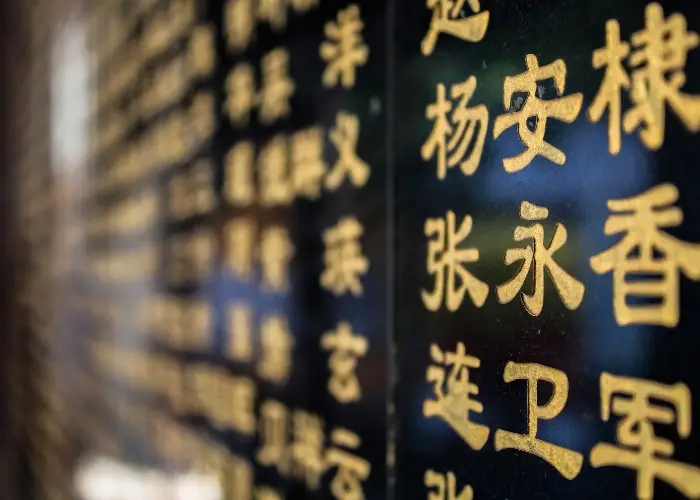The Intriguing Introduction to Feng Shui’s Language
Ever strolled into a space and immediately felt an inexplicable sense of peace or distress? You probably wondered why, right? That’s Feng Shui, the ancient Chinese art, subtly speaking to you. While invisible and often overlooked, it dramatically impacts our daily lives. But have you ever paused to comprehend this age-old wisdom’s language?
From ‘Qi’ to ‘Yin-Yang’, the vocabulary of Feng Shui brims with powerful symbolism representing harmony, elements, directions and more. This lexicon shapes the energetic conversation between us and our surrounding environment.
Imagine understanding these mystical terms as fluently as your native tongue. Wouldn’t it be not just fascinating but empowering? As we begin this evocative journey together into the linguistics of Feng Shui, prepare yourselves for an insightful deep dive; You’re about to become “fluent” in manifesting balance and prosperity using a language thousands of years in making!

Origins and Development of Feng Shui Terminology
Feng Shui, literally translating to ‘Wind-Water’, hails from Ancient China and boasts a rich tapestry of over 3,000 years. This time-tested discipline profoundly involves understanding the energies (known as ‘Qi’) that bind the universe, earth, and humanity together. Over centuries, it evolved into a complex system of cosmological principles and theories incorporating elements from astrology, physics, geography and even philosophy.
The introduction of Chinese characters brought about Feng Shui’s first layer of verbalization. For instance, the character for Qi weaves a captivating tale – combining grains of rice steaming in a pot with mystical vapors representing air or gas; it visualizes our foundational life force’s ethereal nature. Meanwhile terms like ‘Yin-Yang’ emerged as powerful representations for fundamental polarities in life like night-day or female-male.
In its journey westward during the mid-20th Century CE via British colonists stationed in China and later through Chinese socio-diaspora circles worldwide; English-speaking practitioners began to adapt these concepts into familiar language constructs while maintaining original terms to preserve authenticity.
Today’s Feng Shui language is hence an intriguing blend of ancient Chinese wisdom elegantly melded with modern terminologies – rebuilt to authentically convey timeless principles within contemporary context without diluting its essence. Next time you ponder upon phrases such as ‘Bagua Map’ or ‘Five Elements Cycle’, remember you are relishing an old-world concoction seasoned by generations!
Common Feng Shui Terms and What They Mean
Mastering Feng Shui’s vocabulary is a crucial step towards understanding this ancient practice. Some imperative terms that you will frequently encounter are:
1. ‘Qi’ also known as Chi refers to life force or vital energy flowing through all things alive and inanimate.
2. ‘Yin-Yang’ signifies balance – it’s the principle that all things exist as inseparable yet contradictory opposites, e.g., female-male, darkness-light.
3. The term ‘Bagua’, often visualized as a 3×3 grid, is used to map the energies in a given space related to different aspects of life like career, wealth, health among others.
4. ‘Five Elements’, namely wood, fire, earth, metal and water represents cycles of transformational energies influencing our well-being and fortune.
Understanding these basic terms allows you to read your surroundings shrewdly by interacting with moving (wind) or still (water) Qi forces for optimal energy flow within spaces.
Yes! It does sound like deciphering an exquisite riddle. This mysterious language aims to foster harmonious relations between individuals and their immediate environment; ultimately facilitating enhanced wellbeing & prosperity.
Knowing the meanings behind these unique words opens up new vistas of connectivity with our space on a more profound level – like having your personal cosmic GPS guiding you past hurdles towards serenity & success!
It may seem daunting initially but fear not; just consider each unfamiliar term as your compass needle directing you deeper into Feng Shui’s enchanting labyrinth!

Understanding the Five Elements in Feng Shui Language
Delving further into the entrancing narrative of Feng Shui, understanding the Five Elements is a golden chapter. These elements – Wood, Fire, Earth, Metal and Water- are life’s building blocks in Feng Shui language. They symbolize unique types of Qi (energy) within a space and govern relationships between different areas of our lives.
Fascinatingly each element represents certain characteristics:
1. ‘Wood’ depicts growth and vitality – it’s aligned with fresh starts and future projections.
2. ‘Fire’ signifies passion, high energy levels or transformation – it corresponds to reputation and how others perceive you.
3. ‘Earth’, associated with stability & nourishment handles perception of abundance.
4. The metallic luster of ‘Metal’ denotes disciplined efficiency influencing children & creativity sectors in life.
5 “Water”, embodying flow or wisdom has influences over career trajectories.
However, their harmony isn’t standalone but rather interconnected through Cycles – Productive (where one element fuels another) & Destructive (one element restrains another).
For instance – Fire burns Wood creating Earth residue which attracts Metal miners who condense airborne moisture to Water that nourishes Wood; forming the Productive Cycle! Conversely for the Destructive Cycle; Fire melts Metal whose shards chop down Wood which then uproots Earth blocking Water which douses fire!
Balancing these elements in line with specific cycles within spaces can profoundly influence our wellbeing by cultivating supportive energies around us.
This may sound mystical but view it as nurturing your biophilic instincts subtly intertwined within all human threads from time immemorial; prepping you to create harmonious living arenas that vibrate positively with your dreams!
The Interplay of Yin and Yang in Feng Shui Lingo
One simply cannot explore Feng Shui without crossing paths with the iconic Yin and Yang duo! They form the crux of all Feng Shui principles, indicating that everything in our universe has a partner, an opposing yet complimentary force.
‘Yin’, visualized as a darker swirl within the Yin-Yang symbol, connotes receptive, nurturing and feminine characteristics. It’s associated with coolness, introspective traits and signifies earth when speaking from elemental perspective.
Oppositely ‘Yang’, represented by the lighter portion of the emblem – is active, forceful; embodies masculine attributes; exuding warmth akin to a rising sun or fire element.
This metaphorical dance between Yin and Yang revolves around maintaining equilibrium. Too much Yang essentially stirs up hyperactivity while overbearing Yin leads to stagnation. Ever encountered rooms feeling ‘too cold’ or ‘overexciting’? Some unseen imbalance has been poking your intuitive radar – emphasizing this eternal truth!
Feng Shui teaches us how subtly varying shapes (curved for Yin & straight-angular for Yang), colors (pastel-cooler for Yin while bright-vibrant denote yang), furniture positioning etc can harmonize these abstract energies effectively.
This is not about chasing perfection but embracing change dynamics– recognizing that peaks of joy(yang) might be swept by streams of melancholy(yin) – just as day seamlessly blankets into night-time crescent-lit tranquility!
As we delve deeper into orchestrating this balance; let’s remember: success in mastering Feng Shui language beckons those valuing patience & gentle consistent efforts! Ready for more exciting revelations? Stay tuned!

How to Implement Feng Shui Vocabulary in Daily Life
Adapting the principles of Feng Shui and its vocabulary into everyday life can begin in humble strides. Start by dusting off stagnant energies from corners around your abode or workspace; this small act essentially sweeps away ‘bad qi’.
Map out your home-office space using Feng Shui ‘Bagua’ to comprehend different life sectors that could reap benefits of positive energy transformation. For instance, adding a live green plant – symbolizing wood element, in wealth corner promotes prosperity (increase Wood feeds Fire that represents wealth).
Strategically place mirrors to deflect negative energies or amplify beneficial ones. Even colors spin magic! Cooler tones usher Yin serenity while bold hues add vibrant Yang.
Always be mindful about the play of ‘Five Elements’ while decorating – like metal picture frames boasting angular shapes (Yang-metal element) or soft, round leather furniture pieces fostering nurturing vibes(Yin-earth).
Bask under skylights during daytime endorsing Solar Yang force & maintain low-level lighting during quieter evening hours for Lunar Yin embrace.
Remember to balance functionality with aesthetics; surplus unease experienced via impractical beauty teases Qi disharmony!
However amidst these shifts you might question- which altercations are advisable? How much is too much or less? Here’s when fluency in Feng Shui language aids informed choices within varied contexts – harmonizing personal Highs & Lows gracefully with environmental connections enveloping us! Trust your instincts as they narrate spaces’ silent whispers whilst navigating this intriguing journey filled wise cracks resolving many life puzzles!
Feng Shui Lexicon Errors to Avoid
As you implement Feng Shui vocabulary in your life, it’s key to steer clear of a few common misinterpretations that can often skew the essence of this harmonizing art form.
One such mix up includes mistaking ‘Qi’ for physical energy like electricity or magnetism; instead remember – Qi implies the abstract vital life-force subtly influencing environments around us. Further, each Feng Shui term embodies multi-layered connotations – for instance, ‘Yang’ isn’t always blatantly vibrant nor is Yin universally calming; context matters!
Also note that incorporating every element into each Bagua area often backfires. It culminates into elemental conflicts rather than balance – (Would you want fire in water represented career zone or earth hindering wood’s growth within wealth sector?)
Another slip involves getting caught up with exhaustive Bagua application on every room individually instead being applied to dean/ house as a whole.
Furthermore, applying Feng Shui isn’t merely about following textbook rules blindly but understanding core principles underlying desired changes & adapting them per personal preferences & spaces we inhabit daily.
Finally it’s essential to avoid rushing transformations! Realize that Feng Shui is akin to mastering any other language- progress occurs gradually via practiced persistence amplified over time yielding wholesome returns! Patience and keen observation will guide your journey. Intrigued? Let’s continue our exploration further with decoding mysteries behind this ancient practice next!
Decoding the Mysteries: The Role of Language in Feng Shui
The rich lexicon of Feng Shui serves as a potent bridge, connecting us with the ancient wisdom of viewing our surroundings as living entities – vibrant and reactive. The understanding of this unique language amplifies our ability to harmonize with energies in both seen and unseen realms. Essentially, it leads us to foster a nourishing dialog between us and the spaces we inhabit.
‘Qi’, ‘Yin-Yang’, ‘Bagua’, ‘Five Elements’ – these aren’t mere terminologies but depict incredible philosophies encapsulating earth & cosmos secrets! Decoding their essence helps comprehend life’s beautiful complexities woven within crevices of daily mundane!
This immersive narrative unfolds surprising revelations about balance-beauty-betterment triad effectively bridging gaps between personal space (inner self) & physical boundaries (our home/office). We unearth subtleties on how thoughtfully arranged objects spirally influence everyday moments affecting mood-perceptions-actions like invisible ripples!
Our newly learned lexicon instills refined sensibility encouraging mindful observance via symbolic associations. It closely resembles learning life’s new rhythm aligning subtly with universal flows marking nuances missed earlier.
But remember, mastering Feng Shui language doesn’t call for perfect fluency overnight; no stringent dictionary rules limit your journey! In fact, each term is perceived differently through uniquely personal lenses – where feelings-resonances outweigh rigid definitions.
Like poets invoking meaning beyond mere words; practitioners learn crafting fluid co-existence symphony using these mesmerizing vocabularies until melodious harmony seeps deep within their beings around them!

Sign up